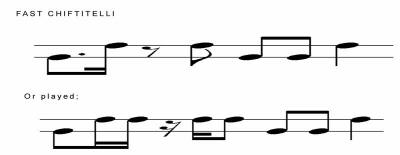If you are new to Arabic music then you might want to
get familiar with a few of the rhythms on this page. These rhythms are
most commonly played on Arabic 'Tabla' (Darabouka - Doumbek) Req,
and Arabic hand drums etc. A good way to get started is to look at
these first four rhythms which are often used in conjunction with one
another in a lot of middle eastern music and belly dance drumming.
These four rhythms are also an excellent skeletal structure to develop a
solo over as a percussionist. This page is more about the rhythms
than the detailed specifics of darabouka technique but, there will be a
page on that coming soon.
CHIFTITELLI. This is usually used for the 'Taqsim'
section of a piece which is where the soloist will develop and improvise
on the scales and melodies of the piece. This is similar to the 'Alap'
section at the beginning of a lot of Indian music.

AUDIO

MAQSOUM. Here the rhythm picks up into a more
'strolling' style.

AUDIO

AYOUB or MALFOUF. This is where the real excitement
and energy of the rhythm is generated.

AUDIO

This next rhythm is often used for the middle eight
section of the piece.

AUDIO

There are also lots of other Middle Eastern rhythms.
Here are a few.
FELLAHI. Related to Malfouf. A fast and
driving 2/4 groove.

AUDIO

SAIDI. Actually, the first bar of this example
is Saidi but Arabic percussionists sometimes omit the dum stroke on the
first beat of the second bar to create an interesting variation.

AUDIO

FAST CHIFTITELLI. Another driving rhythm but
this time in 4/4 rather than 2/4.

BALLADI. A regal 'walking pace' style of rhythm.
This also works well if you play it as a two bar groove and omit the dum
on the first beat of the second bar.

AUDIO

KARSILAMAS. Characteristic Turkish/Greek 9/8
comprising of a 'slow 3' and a 'quick 3'

AUDIO

COPANITSER. Bulgarian, but really in the mood of odd
meter Arabic grooves. This rhythm is divided 4+3+4 and has a
really great feel.

AUDIO

| Embelishing Arabic rhythms |
Arabic rhythms can be developed on Darabouka in a very
logical way, going from 'open' to 'closed' by slowly filling in between
the main beats of the skeletal structure of the rhythm. Here we
have the basic structure of a standard Arabic groove with the right hand
only.
AUDIO OF ALL EMBELLISHMENT LEVELS


Next, on an eighth note level only, we fill in the
three spaces with the left hand as shown below.

Next up, we make each of the new additions into a
sixteenths 'RL' instead of the single left hand note. This is
really starting to add the characteristic feel to the groove.

Then we fill in all the off beat sixteenths with the
left hand. This gives us the 'closed' version of the groove. The
hands will now be playing 'RLRL' throughout.

Following on from there we get into the 'decorative'
embellishments where little ruffs and rolls are added to the groove
using individual fingers of the left hand. Some Arabic traditions
involve the use of all three fingers (excluding pinkie) whilst others
only employ the first and ring finger. I prefer this later option.


